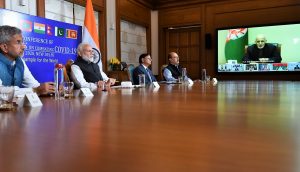By Niranjan Marjani
 The outbreak and spread of COVID-19 has created multiple challenges for the entire world. Apart from containing the spread of virus and treating infected patients, there are related political issues such as the blame game between the United States and China, the role of the World Health Organization (WHO), and questions about the future world order.
The outbreak and spread of COVID-19 has created multiple challenges for the entire world. Apart from containing the spread of virus and treating infected patients, there are related political issues such as the blame game between the United States and China, the role of the World Health Organization (WHO), and questions about the future world order.
Amid this entire crisis, India has been playing an important role. India’s role could be considered at both the domestic level – the steps taken to tackle the crisis at home — and the diplomatic level — India’s assistance to other countries, especially in the Indian Ocean Region (IOR), amid the pandemic.
India’s approach, including on the diplomatic front, has been proactive since the outbreak of the crisis. One of the first steps taken by India was to evacuate citizens of different countries along with its own citizens from Wuhan, China, the epicenter of the first COVID-19 outbreak. Those evacuated as compassionate cases included citizens from IOR countries such as Bangladesh, Myanmar, the Maldives, South Africa, and Madagascar. India not only evacuated these people, but also quarantined them in India as a precautionary measure before sending them to their respective countries.
Second, India has emerged as a major supplier of medicines to different countries worldwide in the fight against COVID-19. As part of that effort, India was the first responder to Mauritius and the Seychelles. Prime Minister Narendra Modi had assured all possible help to both these countries to face the challenge of COVID-19. Accordingly India sent a consignment of life-saving drugs, including hydroxychloroquine, to Mauritius and the Seychelles.
Third, COVID-19 has provided India an opportunity to address the irritants in its ties with some countries, most notably Iran and Malaysia. In the past few months India’s relations with both these countries were strained owing to Iran and Malaysia’s criticisms of India. However, recently India and Iran cooperated with each other in order to evacuate the Indians stranded in Iran. Later Iran’s President Hassan Rouhani wrote to Modi seeking India’s assistance to deal with COVID-19. Rouhani also reached out to Modi with the expectation that India would stand with Iran against the United States’ sanctions. Apart from this, India has sent a wheat consignment to Afghanistan through Iran’s Chabahar port. With respect to Malaysia, India has agreed to supply anti-malarial drugs, indicating improvement in the bilateral relations.
India’s recent actions, which could be termed as humanitarian assistance and disaster relief (HA/DR) operations, build upon its outreach to the IOR, in particular the western Indian Ocean, in the past few years. India has made efforts to reach out to countries like Mauritius and the Seychelles, both of which Modi visited in 2015. In 2018 an agreement between India and the Seychelles was signed to jointly develop a naval base at Assumption Island. Similarly India is engaged in the development of Chabahar port in Iran, which has become operational.
India’s outreach in the IOR and the broader Indo-Pacific Region has been parallel to China’s outreach by way of the Belt and Road Initiative (BRI). India’s competition with China could be considered asymmetric owing to differences in the economic and military capabilities of both countries. However, China’s development projects have resulted in indebtedness for many countries with limited resources. This situation creates an opportunity for India to present its own alternative to countries in the Indian Ocean Region, which would also facilitate increasing India’s footprint in the region.
The COVID-19 crisis presents a similar opportunity for India. This entire crisis has put the focus on China from different quarters. There is a blame game of sorts between the United States and China about the virus, with segments in each claiming that the virus originated from the other. Questions are also being raised about the role of the WHO, with critics saying the global health body was slow to take actions against the pandemic. Moreover, the WHO also defended China when questions were raised about China’s intentions and failure to control the virus.
In contrast, India started screening international travelers in January. On March 25, India announced a lockdown of 21 days, which was later extended until May 3. This is considered an unprecedented step from India, since its population of more than 1.3 billion makes it the biggest lockdown in the world. Many countries including the United States, Italy and Spain were slow to announce their own lockdowns and as a result are the worst-affected countries, with hundreds of thousands of COVID-19 cases and deaths in the tens of thousands. In comparison, India’s numbers stand at around 20,000 infected and 645 dead as of April 22. India has also received praise from institutions such as the UN, the WHO, and the IMF for the response to this crisis.
The COVID-19 crisis has raised a debate about the future world order. At present, more and more countries in the world have an unfavorable opinion about China. On the other hand, India has been nimble-footed enough to take this opportunity and build up goodwill, which could result in elevated status in the post-COVID-19 period. India has also concentrated most of its efforts in the strategically important Indian Ocean Region, which has given it leverage. India’s diplomacy in the IOR could define its position in the changed world order.
Niranjan Marjani is a political analyst and researcher based in Vadodara, India. Follow him on Twitter: @NiranjanMarjani
No comments:
Post a Comment